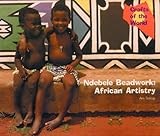
Ann Stalcup. Ndebele Beadwork: African Artistry. New York: Rosen Publishing Group, 1999. 24 pp. $18.00 (cloth), ISBN 978-0-8239-5336-3.
Reviewed by Lesego Malepe (Wheaton College)
Published on H-AfrTeach (November, 1999)
The idea of this book, showing Ndebele beadwork is a good one. Unfortunately it is done in a way that makes the Ndebele look fundamentally different from the author's "you and me". They are portrayed as exotic and the tone of the book is generally patronizing and condescending.
For example, Ndebele traditional clothes are referred to as "costumes". It is as though the Ndebele are not people going on about their lives but actors taking part in some theatrical show. The author writes, "For many years, the Ndebele have worn the same kind of clothing that you and I wear. But on special occasions they wear traditional costumes." Why is the word 'costume' reserved for them while we would probably be referred to as wearing traditional fashions? It is as thoughthe Ndebele are the only people who wear special clothes on special occasions. One wonders why they cannot wear traditional fashions the same way "you and I" would wear the traditional fashion of a white dress on our wedding day. Costume makes it theatre.
Later the author states, "Ndebele houses on the farms are simple. They have no telephones or TVs. But TVs are often painted on the walls of homes, along with lightbulbs and airplanes! The Ndebele have seen these items, and paint them, even though they are not part of Ndebele life on the farms". The author fails to note that the reason they are not part of life on the farm is poverty. In fact the houses are "simple" only because the people are poor and cannot afford to build more solid and expensive homes. This obvious explanation would ruin the exotic and cloyingly cute picture of Ndebele life being drawn here. Those who can, build less "simple" homes. And of course, like everybody else, the farm Ndebele would prefer not to walk long distances to find a phone. There is an implicit refusal here to see the Ndebele as being like us in any fundamental way. Unfortunately this view of the Ndebele as simple people leading simple lives was the basis of one of the twisted arguments used during the Apartheid era to justify paying Africans absurdly low wages. Since Africans live such simple lives, the argument went, they don't need much money, as though Africans did not desire to live comfortably in spacious houses.
The author goes on, "Today many Ndebele live in cities. Their lives are very much like the lives of people who live in cities in other parts of the world. But the Ndebele who live on farms are different. They follow Ndebele traditions." The book gives an erroneous picture of farm life as being very separate from city life which in South Africa's is not the case. A lot of people in Ndebele areas work in towns, some of them riding buses for two and a half to three hours to go to city jobs. In fact, it would be hard to find an Ndebele family without links to relatives in some city or town. Failing to see this, makes it possible for the author to talk about the 'traditional' in a simple way that ignores the complexity of Ndebele life on the farms.
The last sentence of the book states, "The Ndebele are most proud of keeping their houses freshly painted and creating beadwork for others to see." Most proud of beadwork and painting? Doubtful. This continues the notion of the Ndebele women as simple folk aspiring for nothing more than keeping their houses freshly painted. It is reminiscent of the old stereotype of 'housewives' as simple people who desired nothing more than to keep their houses clean, cook and make everybody happy.
The book is somewhat redeemed by the craft-making section at the end, which is fun and interesting. Overall, however, the book resembles ones sold at the popular 'Ndebele Village' constructed for tourists, near Pretoria. It certainly belongs there.
This critique might sound hard particularly for a kid's book on beadwork, but this simplistic view of the Ndebele as simple folk has become so prevalent and pervasive that I would be remiss not to point it out.
Copyright (c) 1999 by H-Net, all rights reserved. This work may be copied for non-profit educational use if proper credit is given to the author and the list. For other permission, please contact H-Net@h-net.msu.edu.
If there is additional discussion of this review, you may access it through the network, at: https://networks.h-net.org/h-afrteach.
Citation:
Lesego Malepe. Review of Stalcup, Ann, Ndebele Beadwork: African Artistry.
H-AfrTeach, H-Net Reviews.
November, 1999.
URL: http://www.h-net.org/reviews/showrev.php?id=3575
Copyright © 1999 by H-Net, all rights reserved. H-Net permits the redistribution and reprinting of this work for nonprofit, educational purposes, with full and accurate attribution to the author, web location, date of publication, originating list, and H-Net: Humanities & Social Sciences Online. For any other proposed use, contact the Reviews editorial staff at hbooks@mail.h-net.org.

